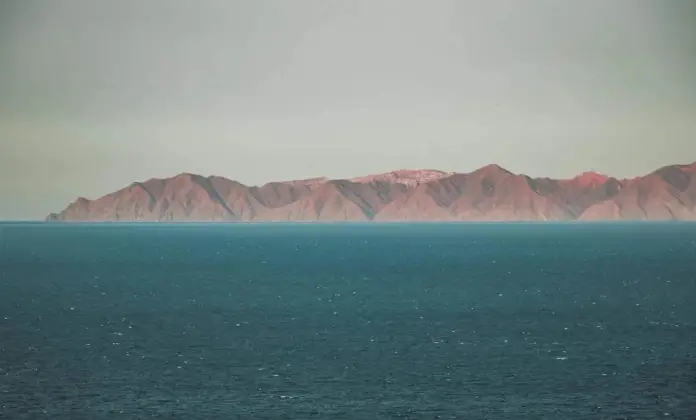A post on an online sales platform has sparked a heated discussion about the ownership and future of one of the state’s most valuable natural spaces: Cerralvo Island.
The listing, hosted on the MercadoLibre portal and promoted by the real estate agency KW Metropolitan, offers the island for sale for $115 million, equivalent to more than 2.242 billion Mexican pesos, starting in December 2024.
It is located in the Gulf of California, off the eastern coast of the Mexican state of Baja California Sur.
It is located approximately 65 kilometers east of the city of La Paz, about a 40-minute drive. It is 16 kilometers east of the town of La Ventana and can be seen from the coast, separated from the mainland by the Cerralvo Channel.
With a length of 29 kilometers and a maximum width of 7 kilometers, the island covers an area of 136.5 square kilometers, making it the ninth largest island in Mexico.
The proposal describes a “sustainable development” project on 11,300 hectares, including infrastructure for maritime, air, and land transportation, eco-friendly hotels, sustainable housing, renewable energy, an airport, and ecotourism zones, among other ambitious plans.
According to the description, the island, officially known as “Jacques Cousteau Island” since 2009, would feature:
Eco-friendly villages.
A wind and offshore power plant.
A wastewater treatment and water treatment plant.
Boats, piers, and ferries for cargo and tourism.
National parks for sea turtle conservation.
The governor of Baja California Sur, Víctor Manuel Castro Cosío, spoke out on the issue, asserting that Cerralvo Island is a national heritage site and should not be for sale.
“Look, what I do know is that when I was mayor, I checked whether that island is privately owned by a South Californian family, the Ruffo family. I don’t know if there are other owners, but the Ruffo family owned Cerralvo Island. You know that the privatization of these spaces was possible before,” Castro Cosío declared.
The president emphasized that, even if private property exists, “all islands, seas, and lands” should be considered national heritage. “I oppose the privatization of our islands,” he stated.
Castro Cosío called on the relevant authorities to review the island’s legal status to prevent its sale or private development that would affect its heritage status. “I hope that those in charge of this extremely important territory of ours do not sell it,” he declared.
Cerralvo Island is one of the most important ecological sites in the Gulf of California due to its rich marine and terrestrial biodiversity.
It is an important migration and breeding point for species such as yellowfin tuna, horse mackerel, sailfish, dorado, and marlin. Dolphins and gray, humpback, and blue whales are commonly seen in the nearby waters.

Its environment is home to hammerhead sharks, bull sharks, and silky sharks. Seabirds such as the brown booby, frigate birds, yellow-legged gulls, and Leach’s storm petrel also live there, some of which are granted special protection by the environmental authority. Terrestrial species such as the spiny-tailed iguana, endemic to the Gulf Islands, have been recorded.
What does Article 27 of the Mexican Constitution say?
According to Article 27 of the Mexican Constitution, only Mexicans by birth or naturalization, as well as Mexican corporations, may acquire ownership of land and waters in the country.
Foreigners may acquire property under certain conditions, but not within the 50-kilometer zone along the beaches.
Furthermore, reforms to the General Law of National Property and the Agrarian Law have strengthened the protection of Mexican island territory, preventing the alienation of islands considered national property.
Although there are precedents for privately owned islands, such as Cerralvo Island itself, the possibility of their sale is surrounded by environmental and legal restrictions.
In 2005, the island was classified along with 244 other islands as a World Heritage Site by the United Nations Educational, Scientific, and Cultural Organization (UNESCO) as part of the islands and protected areas of the Gulf of California.
An ambitious and controversial project
The project promises clean energy, sustainable infrastructure, environmental conservation, and eco-tourism. However, environmental law specialists and environmental organizations warn of the risks of modifying highly sensitive island ecosystems.
Many Mexican islands are located in protected natural areas, which limits their development and use.
Any construction project requires permits from various authorities, including the Environmental Impact Statement (EIS) from the Ministry of Environment and Natural Resources (Semarnat).
Other aspects to consider are the logistical difficulties of access, the lack of services, and the complexity of installing truly sustainable infrastructure in practically pristine areas.
History of Private Island Ownership
The existence of private islands in Mexico is not new. San José Island, also in Baja California Sur, is an example of private ownership. However, these situations date back to decades past, when legislation was more permissive regarding the disincorporation of national assets, according to Governor Castro Cosío.
Today, under current laws, the trend is toward the conservation of island spaces, restricting their sale or mass development.
The announcement remains active at press time.

Source: oem




